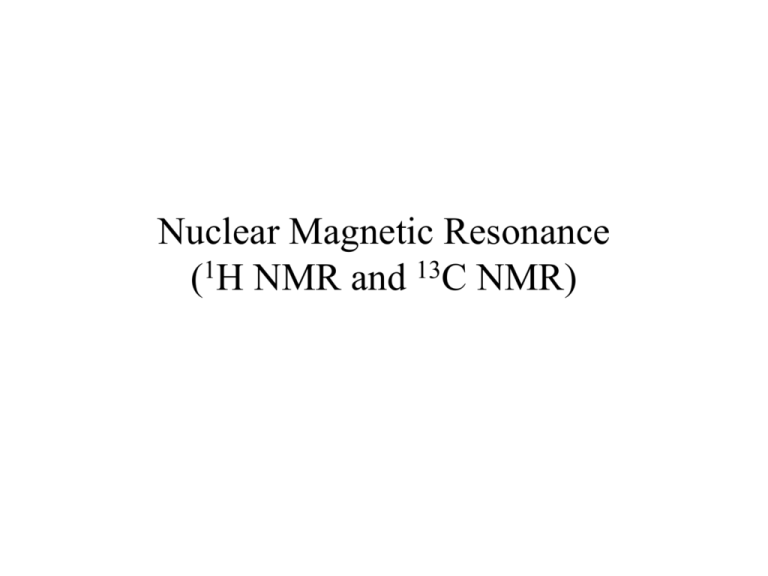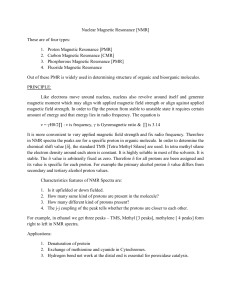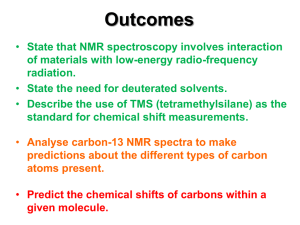Nuclear Magnetic Resonance (1H NMR and 13C NMR)
advertisement

Nuclear Magnetic Resonance (1H NMR and 13C NMR) Magnetic field is created by a spinning charge. The resultant magnetic dipoles of nuclei (I =1/2) are aligned with the external magnetic field Bo as shown Splitting of energy levels for a nucleus with I = ½, such as hydrogen, in an external magnetic field A diagram of a continuous wave NMR (CWNMR) instrument. The sweep coils are used to modulate the strength of the external magnetic field The NMR tube the NMR tube Solvents must not contain protons CCl4 20 cm 5 mm diameter CDCl3 O D3C S CD3 dimethyl sulfoxide-d6 (DMSO) the solution (0.7 ml) CH3 H3C Si CH3 CH3 tetramethylsilane (reference) (TMS) The shielding effect In an applied magnetic field, magnetic nuclei like proton precess at a frequency ν, which is proportional to the strength Bx of the applied field: ν = γBx/2π precession orbit magnetic dipole created by proton spin H0 external magnetic field δ = (νmol – νTMS)/ν x 106 Proton chemical shift ranges for samples in CDCl3 solution. The δ scale is relative to TMS at δ = 0 If electron density is withdrawn from around the hydrogen nucleus toward a more electronegative atom, the lower electron density around this hydrogen atom will produce a smaller magnetic field (opposite to the magnetic field of the spectrometer) and, as a result, this proton will be deshielded and will resonate at a position farther downfield (farther to the left in the spectrum). For example: CH3-CH3 CH3-Cl CH3-OCH3 δ 0.26 δ 3.06 δ 3.24 Integration of the NMR spectra The effect of the H – D exchange on the NMR spectra R-O-H + D2O R-O-D + D-O-H The hydroxyl proton can resonate over a large range of chemical shifts but hydrogen bonding results in the resonance at a lower magnetic field or higher frequency. Because of their favored hydrogen-bonded dimeric association, the hydroxyl proton of carboxylic acids displays a resonance signal significantly downfield of other functions Magnetic anisotropy at the benzene ring The spectra with and without a coupling pattern Typical coupling patters If an atom under examination is perturbed or influenced by a nearby magnetic field caused by a nuclear spin (or set of spins), the observed nucleus responds to such influences, and its response is manifested in its resonance signal. This spin-coupling is transmitted through the connecting bonds, and it functions in both directions. Spin – spin coupling for -CH2-CH3 For a CH2 group adjacent to a methyl group, there will be four peaks, created by the spin orientations of the methyl protons shown below 1 2 2 2 3 3 3 4 A quartet for –CH2-CH3 Four signals with the relative intensity of 1:3:3:1 = quartet 1 2 3 Energy 4 The “roof effect” for coupled protons Pascal’s triangle (the intensity ratio) The splitting pattern of a given nucleus (or set of equivalent nuclei) can be predicted by the n+1 rule, where n is the number of neighboring spin-coupled nuclei with the same (or very similar) Js. If there are 2 neighboring spincoupled nuclei, the observed signal is a triplet (2 + 1 = 3); if there are three spin-coupled neighbors, the signal is a quartet (3 + 1 = 4 ). In all cases the central line(s) of the splitting pattern are stronger than those on the periphery (the “roof effect”). 1 1 1 1 3 3 1 4 1 2 1 6 1 4 1 Typical coupling patterns with a single coupling constant J Typical coupling patters with different coupling constants Js Typical values of coupling constants Js (in Hz) 13C NMR spectroscopy When significant portions of a molecule lack C-H bonds, little information is forthcoming by 1H NMR. The following diagram depicts three pairs of isomers (A & B) which display similar proton NMR spectra. 13C NMR spectroscopy 13C isotope has a spin I = ½ (is magnetic) 1.1% of natural carbon is the 13C isotope In 13C NMR spectroscopy, the sample is irradiated with a relatively intense range of frequencies that correspond to precessional frequencies of all protons in the molecule. As a result, these protons become saturated, no further absorption of the irradiation energy is possible, and the protons are no longer coupled to 13C nuclei. Proton-decoupled 13C NMR and 1H NMR spectra of camphor 13C NMR chemical shifts for various classes of compounds. The δ scale is relative to TMS at δ = 0 The isomeric pairs previously examined as giving very similar proton NMR spectra can be distinguished by carbon NMR spectroscopy. Cyclohexane (A): a single signal at δ 27.1 Alkene (B): two signals at δ 20.4 and δ 123.5 Fulvene (A): five signals ortho-Xylene (B): four signals Quinone (A): four signals Quinone (B): five signals Graduate Studies in Chemistry • Competitive stipends and fellowships; waived tuition; and assisted health insurance (PhD’s supported: 82) • Ranked top 10 of 178 by National Research Council in “Student support and Outcomes” and “Faculty Diversity” MS and PhD Programs offered in: • • • • Analytical Biological / Biochemical Biophysical / Computational Organic / Medicinal http://www.nap.edu/rdp/ • For more information: www.chemistry.gsu.edu chegsc@langate.gsu.edu Masters program ranked number 9 in the United States (number one in the Southeast) by the American Chemical Society for MS degrees conferred in 20082009 http://pubs.acs.org/cen/email/html/8834acsnews1.html 30 Center for Diagnostics and Therapeutics 31 32 33







